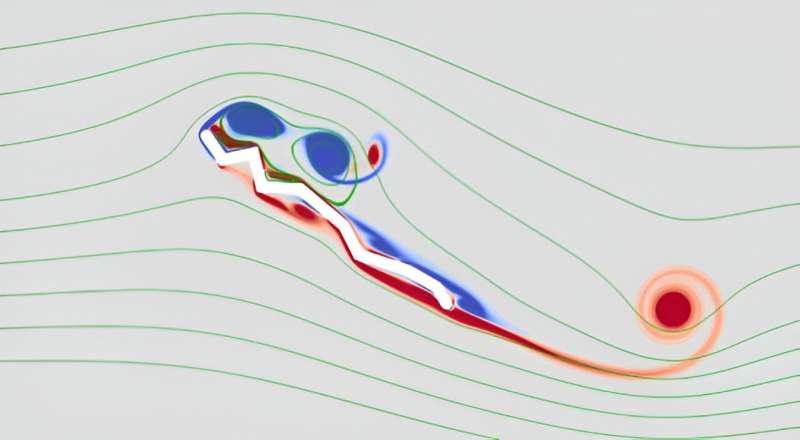This article has been reviewed according to Science X's editorial process and policies. Editors have highlighted the following attributes while ensuring the content's credibility:
fact-checked
peer-reviewed publication
trusted source
proofread
Using dragonfly wings to study the relationship between corrugated wing structure and vortex motions

Scientists from Hiroshima University undertook a study of dragonfly wings in order to better understand the relationship between a corrugated wing structure and vortex motions. They discovered that corrugated wings exhibit larger lift than flat wings.
Their work was published in the journal Physical Review Fluids on December 7, 2023.
The researchers set out to determine if the corrugation of a dragonfly's wing is a secret ingredient for boosting lift. While past research has largely zoomed in on the steady flow around the wing during forward motion, the impact of vortices spawned by its corrugated structure on lift has remained a mystery.
The wing surfaces of insects like dragonflies, cicadas, and bees, are not flat like the wings on a passenger plane. The insect wings are composed of nerves and membranes, and their cross-section shapes consist of vertices (nerves) and line segments (membranes). The geometry of the shape appears as a connection of objects with a V-shape or other shapes.
Earlier studies have shown that corrugated wings, with their ridges and grooves, have a better aerodynamic performance than smooth wings at low Reynolds numbers. In aerodynamics, the Reynolds number is a quantity that helps predict the flow pattern of fluids.
Earlier aerodynamic studies on corrugated wings have contributed to applications in small flying robots, drones, and windmills. Because insects possess low muscular strength, in some way their corrugated wings must give them aerodynamic advantages. Yet scientists have not fully understood the mechanism at work because of the complex wing structure and flow characteristics.
The researchers used direct numerical calculations to analyze the flow around a two-dimensional corrugated wing and compared the corrugated wing performance to that of a flat wing. They focused their study on the period between the initial generation of the leading-edge vortex and subsequent interactions before detachment.
They discovered that the corrugated wing performance was better when the angle of attack, that angle at which the wind meets the wing, was greater than 30°.
The corrugated wing's uneven structure generates an unsteady lift because of complex flow structures and vortex motions. "We've discovered a boosting lift mechanism powered by a unique airflow dance set off by a distinct corrugated structure. It can be a game-changer from the simple plate wing scenario," said Yusuke Fujita, a Ph.D. student at the Graduate School of Integrated Sciences for Life, Hiroshima University.
The researchers constructed a two-dimensional model of a corrugated wing using a real-life dragonfly wing. The model consisted of deeper corrugated structures on the leading-edge side and less deep, or flatter, structures on the trailing-edge side.
Using their two-dimensional model, they further simplified the wing motion and focused on unsteady lift generation by translating from rest. Translational motion, or sliding motion, is a principal component of wing motion, in addition to pitching and rotation. The researchers' analysis expands the understanding of the non-stationary mechanisms that dragonflies use during flight.
The research team considered two-dimensional models in their study. However, their work focused on the aerodynamics of insect flight, where the flow is typically three-dimensional.
"If these results are expanded to a three-dimensional system, we expect to gain more practical knowledge for understanding insect flight and its application in the industry," said Makoto Iima, a professor at the Graduate School of Integrated Sciences for Life, Hiroshima University.
Looking ahead, the researchers will focus their investigations on three-dimensional models. "We kicked things off with a two-dimensional corrugated wing model in a sudden burst of motion. Now, we embark on the quest to explore the lift-boosting across a broader range of wing shapes and motions. Our ultimate goal is crafting a new bio-inspired wing with high performance by our lift-enhancing mechanism," said Fujita.
More information: Yusuke Fujita et al, Dynamic lift enhancement mechanism of dragonfly wing model by vortex-corrugation interaction, Physical Review Fluids (2023). DOI: 10.1103/PhysRevFluids.8.123101
Journal information: Physical Review Fluids
Provided by Hiroshima University





















